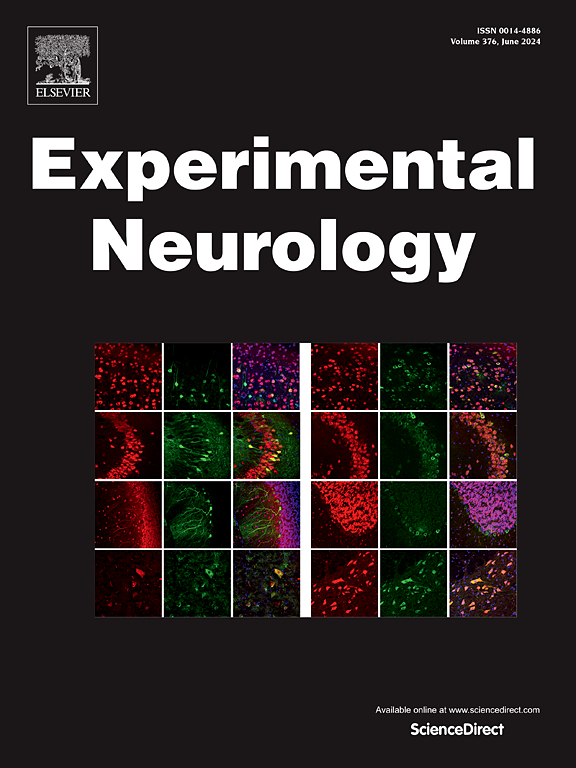Lipocalin 2 mediates kidney function abnormalities induced by ischemic stroke in mice: Involvement of neural pathways
IF 4.6
2区 医学
Q1 NEUROSCIENCES
引用次数: 0
Abstract
Background
Kidney function abnormalities is a common complication following ischemic stroke. Lipocalin 2 (LCN2) is currently a well-recognized specific biomarker of tubular injury. However, the role of LCN2 in kidney function abnormalities following stroke remains elusive. The sympathetic nervous system plays a crucial role in linking the brain and kidney. However, whether the kidney sympathetic nervous system regulates the expression of LCN2 following ischemic stroke has not been identified.
Methods
In this study, we established a middle cerebral artery occlusion (MCAO) model to induce ischemic stroke in mice. Renal function was assessed 24 h after cerebral ischemia-reperfusion injury. Transcriptomic sequencing of kidney tissue was performed to identify potential pathological mechanisms. The role of LCN2 in post-stroke renal injury was investigated using renal tubule-specific LCN2 knockout mice and a combination of qPCR, western blotting, immunofluorescence, and transmission electron microscopy. In addition, renal denervation (RDN) was used to explore the relationship between sympathetic nerves and the expression of renal LCN2.
Results
Ischemic stroke significantly exhibits renal functional impairment 24 h after reperfusion. Notably, RNA sequencing and Western blotting revealed a markedly increased expression of renal LCN2 following ischemic stroke. Renal tubular Lcn2-specific knockout significantly ameliorated the occurrence of kidney function abnormalities after stroke. Subsequently, we observed that the activation of renal sympathetic nerves upregulates LCN2 and induces kidney function abnormalities after stroke.
Conclusions
These findings reveal a neural pathway in which the sympathetic nervous system upregulates LCN2, providing potential therapeutic strategies for renal protection following ischemic stroke.

脂钙蛋白2介导小鼠缺血性中风引起的肾功能异常:参与神经通路
背景:肾功能异常是缺血性脑卒中后常见的并发症。脂载蛋白2 (Lipocalin 2, LCN2)是目前公认的小管损伤特异性生物标志物。然而,LCN2在脑卒中后肾功能异常中的作用尚不明确。交感神经系统在连接大脑和肾脏方面起着至关重要的作用。然而,肾交感神经系统是否调控缺血性脑卒中后LCN2的表达尚未确定。方法建立小鼠大脑中动脉闭塞(MCAO)模型诱导缺血性脑卒中。在脑缺血再灌注损伤后24 h评估肾功能。对肾组织进行转录组测序以确定潜在的病理机制。采用肾小管特异性LCN2敲除小鼠,结合qPCR、western blotting、免疫荧光和透射电镜研究LCN2在脑卒中后肾损伤中的作用。此外,采用肾去神经(RDN)法探讨交感神经与肾LCN2表达的关系。结果缺血性卒中再灌注24 h后肾功能明显受损。值得注意的是,RNA测序和Western blotting显示,缺血性卒中后肾LCN2的表达明显增加。肾小管lcn2特异性敲除可显著改善脑卒中后肾功能异常的发生。随后,我们观察到肾交感神经的激活上调LCN2并诱导中风后肾功能异常。结论这些发现揭示了交感神经系统上调LCN2的神经通路,为缺血性脑卒中后肾保护提供了潜在的治疗策略。
本文章由计算机程序翻译,如有差异,请以英文原文为准。
求助全文
约1分钟内获得全文
求助全文
来源期刊

Experimental Neurology
医学-神经科学
CiteScore
10.10
自引率
3.80%
发文量
258
审稿时长
42 days
期刊介绍:
Experimental Neurology, a Journal of Neuroscience Research, publishes original research in neuroscience with a particular emphasis on novel findings in neural development, regeneration, plasticity and transplantation. The journal has focused on research concerning basic mechanisms underlying neurological disorders.
 求助内容:
求助内容: 应助结果提醒方式:
应助结果提醒方式:


